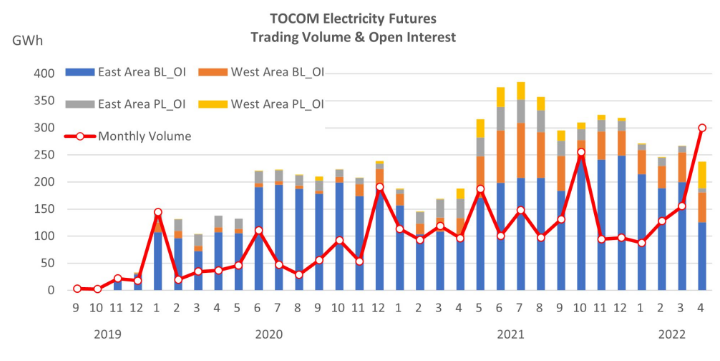TOCOM Energy
JPX Energy Market Updates(May 23, 2022)
The oil market wrapped up another volatile week, swinging up and down in a wide range as it was pulled between bullish and bearish catalysts in both directions and different time horizon every day. The broadening consequences of the war in Ukraine and hawkish US fed monetary policy to bring down inflation have continued to result in rising oil and financial market volatility.
In the short term, there are growing concerns over the refined products market. What started out as a tight middle distillate market appears to be spreading into the gasoline market with EIA reporting another significant draw in gasoline inventories and higher implied domestic demand.
Despite pessimistic economic expectations, with an expected return of Chinese demand, summer driving picks up and jet fuel continues to recover, global refinery output is struggling to keep pace to ease product supply tensions, crude oil demand remains robust. Oil prices reflect those tensions as North Sea Dated Brent prices have moved from discounts to ICE Brent futures to premiums since the beginning of May. Intermonth spread of major crude oil benchmarks also strengthened last week, with the spread of JPX Dubai crude oil future contract for July and September settling equally around 4.8$ per barrel.
In the physical market, Asian demand for July-loading Middle East medium sour grades such as Oman Blend, Upper Zakum is reported to stay strong as these grades have more gasoil yield and refinery margins for middle distillates remain healthy. The spread of JPX Dubai and ICE Brent could be well supported at current level. In addition, the spread of INE Shanghai crude oil and JPX Dubai price difference is also likely to widen because of a tightening of most of the deliverable oil grades and a lower standard warrants.
The Asian gasoil market has been on a strong footing since the beginning of the year due to limited supply, the supply tightness had been further exacerbated by the war in Ukraine, which has led importers based in Europe to seek gasoil from alternate origins to reduce their reliance on Russian barrels, resulting in a strong pull for Asian gasoil barrels from the West. Reflecting the increased flows of Asian gasoil to the West, the volume of ultra-low sulfur diesel arriving from East of Suez to Europe rose 12% on month to about 1.66 million mt, according to reports by Platts. Data analysis shows that the production profit of diesel and jet fuel are highly correlated with the overall refining margins of a refinery.
While Russian flows to Asia reportedly continue, this has done little to dent sentiment for Middle East medium sour crudes. Market participants feared Middle East medium sour crude could be pressured by regional refiners, including those in India and China, considering opting for cheaper Russian grades such as medium sour Urals.
Chinese demand has been a concern due to lockdowns hurting oil and product consumption, but signs of improvement were now visible. ChemChina as well as independent refiners were heard to have bought a total of around 14 million barrels of various Middle East crudes earlier in the July trading cycle. According to market sources, China is likely to see a second batch of oil product export quotas released in June besides a temporary supplementary quota released last friday, which could lead to further appetite for crude buying interests.
Lastly, Limited arbitrage barrels from the West have also boosted interest for Middle East grades. The Brent-Dubai spread, or the Exchange of Futures for Swaps, or EFS, is often tracked as an indicator of North Sea low sulfur crude value versus Middle East high sulfur crude, and a wider EFS makes crude priced against Dubai more economically attractive compared to Brent-linked ones. Since the outbreak of Ukraine war, the benchmark Brent crude has maintained at a premium level to other market. WTI has been gaining prominence lately due to Europe's move to impose a formal embargo on oil from Russia, which is pushing countries in the bloc to race to secure supplies from other markets including the US. At the same time, U.S. refiners are also trying to ramp up activity to meet demand, which is also squeezing WTI higher. last Tuesday, WTI price crossed Brent to trade at $115.4/b vs.115.2/b, take pipeline costs, transportation costs into consideration, arbitrage window is shut to East and to Europe. Iraqi grade Basrah Medium has emerged as a choice for Mediterranean and Northwest European refiners switching from Russian grades.
In the medium term, As high energy prices impact every part of the economy, the fight against inflation becomes more complicated for monetary policymakers, including the US Fed, as steeper interest rate hikes could lead to the deterioration of economic activity, household spending and ultimately recession, a flattening US bond yield curve also signals a possible recession, however, this worry has yet to be reflected within actual demand data.






